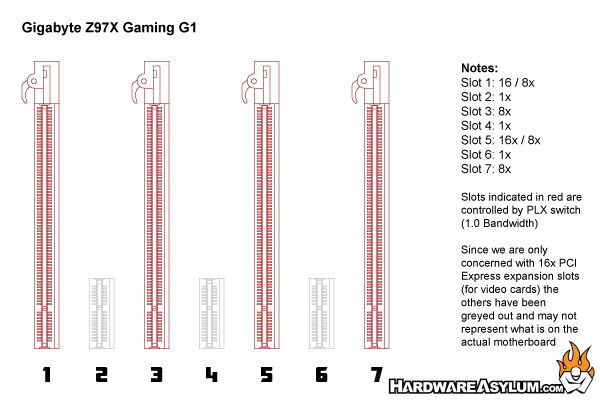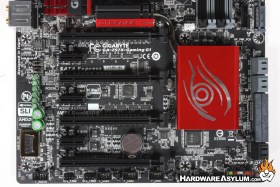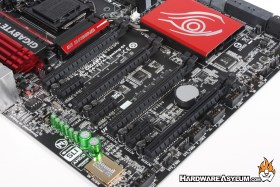Gigabyte Z97X Gaming G1 Motherboard Review
Author: Dennis GarciaMulti GPU Index
The Hardware Asylum Multi-GPU index is a portable set of data we can use to determine the multi-GPU potential of any motherboard. A higher index number indicates a favorable condition for multiple graphics cards while a lower number indicates a hindrance in one of our leading indicators. Since the Index is not dependent on system architecture it can be applied to any motherboard regardless of processor or chipset generations.
Index: 4.75
Optimized: 4x
Max Support: 4x
NVidia SLI
AMD Crossfire

As indicated by the PCI Express layout chart there are a total of four 16x PCI Express slots on this motherboard with all of them using bandwidth earmarked for video cards. Slot one is your primary video card slot and will run at a full 16x when only a single card is installed. Slots One Three, Five and Seven are all powered by the onboard PLX PEX 8747 a 5-port 48-lane PCI Express switch. The primary graphic slots will be One and Five which in turn share bandwidth with their nearest downstairs neighbor.
For best video performance you will want to populate slots one and five with video cards. For proper triple card configurations, using either NVidia SLI or AMD Crossfire, you'll populate slots One, Three and Five. This configuration will give you ample room for dual slot coolers and still remain within the confines of the standard ATX form factor.
During our testing we use four HD4850 video cards to test how the PCI Express bandwidth is divided up. The single slot cooler found on the HD4850 allows us to test any slot configuration and also determine where the bandwidth is coming from. Based on our tests the Z97X Gaming G1 is optimized for quad card configurations but works equally well in dual card operation. If you plan to run two or more cards be sure to connect a SATA power connection to the motherboard. This will enable the PLX chip and activate the remaining PCI Express slots.



